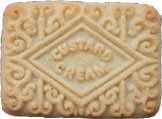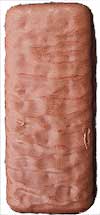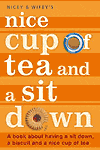Your ViewsKeep your e-mails pouring in, it's good to know that there are lots of you out there with views and opinions. To help you work out what is what, are now little icons to help you see biscuit related themes. And now you can see at a glance which are the most contested subjects via this graph (requires Flash 6.0 plugin). Please keep your mails coming in to nicey@nicecupofteaandasitdown.com | If you like, you can use this search thingy to find stuff that matches with any of the icons you pick, or use the fantastic free text search, Yay! | Your e-Mails |
Tom Stevenson

Custard Cream Review |
Love your site, it makes me laugh no end.
One thingthat I think should be mentioned whilst talking about the legendary Custard Cream, in my opinion the "Holy Grail" of the biscuit world is that rather than simply taking them apart, as you discuss, you can take two apart, dunk the sides that managed to separate themselves from the cream and then stick the two creamy halves together to produce a kind of double cream custard cream as a sort of "pudding biscuit" for the post-dunk comedown
Tom. |
| Nicey replies: Nice plan Tom. I imagine this could be extended with out too much trouble to encompass other sandwich biscuits such as Bourbons and Orange creams. |
| |
| Mark Greenwood |
Nicey,
I'm new to your site but reading Jim Fussel's question about the colour of the mug affecting the quality of the tea reminded me of an experiment I did quite some time ago, before I had a life, to investigate this very phenomenon.
Being a true scientist, I didn't keep any notes so what follows is from memory. Basically I reasoned that water temperature is crucial to the proper brewing of tea so if the colour of the mug had an effect on the water temperature then this might be a possible explanation for the "dark mug
makes bad tea" phenomenon. As I'm sure we all know from school physics, a dark body (or mug) will radiate heat better than a light coloured mug (the so-called 'black body radiation'). So when we pour boiling water into a mug, it will cool down faster if that mug is darkly coloured. To prove this I pointed an infra-red thermometer at the outside of a white mug and a black mug while I brewed some tea. After a regulation brewing period the thermometer measured that much more heat was being given off by the black mug. Investigation of the water temperature inside the mug revealed that the water in the black mug was about 3 degrees cooler than the water in the white mug. So my theory was correct - the black mug allowed the water to cool down faster. Whether this actually makes any difference to the quality of the tea I have no idea, but it sure sounds plausible. As I recall, further investigation was hampered by the fact that I now had two mugs of tea in front of me and therefore it was necessary to go and have two sit downs, by which time the urge for discovery had left me.
Mark |
| |
| Joanne Fry |
Sorry, but this important question has just come up - surely if you put cold milk in tea there is no need to pour out hot tea and replace it with cold tap water? Similarly, why is it that although in posh coffee houses they make coffee with hot milk, no-one ever makes tea with hot milk - why not?? |
| Nicey replies: All to do with the denaturation point of casein the main protein in milk. By forming complexes with the tannins in the tea the milk protein softens the taste, which is how most of us like our tea. Hot milk doesn't do this as well because the protein is all mashed up. Of course this was the central point to the recent study by the Royal Society of Chemistry on tea making. |
| |
Suzy

Penguin Review |
Hi Nicey,
Once I heard about the Tim-Tam Slam I instantly saw the potential of this phenomenom to add itself to our biscuit munching habits here in the UK. I endeavored to discover the suitability and technique for several of our British wrapped biscuits.
Report 1: The Penguin
This was an obvious first choice because of its similarity to the Tim-Tam. I bit the biscuit at either end to allow for tea passage. As the biscuit gets melty if held, I recommend this is done without hands, simply holding the biscuit carefully in your mouth and dipping the end into the tea. I sucked until the chocolate on the outside began to melt slightly, then withdrew the biscuit from the tea and, using slight incline of the head, flicked the biscuit into my mouth.
Result: The Penguin may be a denser biscuit than the Tim Tam, but it is still eminently suitable for Slamming. The technique is tricky and could get messy for beginners, so using a finger to usher the biscuit in and using a shorter length of biscuit are both acceptable and often recommended. Caution must be advised to avoid risk of choking.
Report 2: The Rocky Bar
Next I tried the Rocky Bar, a sweet light golden biscuit topped with a small layer of caramel and coated with a strange chocolate that tastes milky and not as smooth as Cadbury's chocolate. I tried exactly the same technique as with the Penguin.
Result: An excellent success. Although the chocolate seems cheaper there is more of it. The biscuit is lighter and absorbs tea very well,and the caramel adds a soft chewy egde that was most agreeable. The same cautions as for the Penguin must be applied.
Report 3: The Kit-Kat
Here I was taking a risk. Would wafer be suitable for tea-sucking purposes? Would the thin fingers remain stable, or would it be a cardboard soggy mess? I bit the ends off the single finger of Kit-Kat, and was drawn between whether to bite the finger in half for two shorter slams or whether I should do it in one. In the end I tried both, and proceeded with the Penguin Method.
Result: Fairly good, considering that I am not a wafer fan. The Kit-Kat remained stable but the full length test required me to use hands and bite it twice to get it all in my mouth, definitely a messy endeavor. I would recommend the two-halves method, which gave a smaller, hotter Slam but one that can be done hands free without risk of too much mess.
Conclusion:
The preliminary tests have gone very well, and suggest that these British wrapped biscuits are indeed suitable for Slamming. More tests must be done on a wider range of our biscuits forthwith! Well done to the Australians for pioneering the technique.
Sincerely,
Suzy. |
| |
| Nick Marsh |
When I was an engineering student in the early nineties, I lived on the twelfth floor of a block of flats. Often, after lectures, my friend Neal would often drop by to discuss studies..... or, perhaps more honestly, to partake of a nice cup of tea and whatever I had in the cupboard (biscuits were too expensive in those days). Following the brewing stage, we got into the habit of dropping our teabags out of the window for entertainment, preferably when other students were coming out of the rear entrance. However, I was most disappointed with the impact of standard square teabags
and, with my aerodynamic knowledge to hand, decided to try out round teabags - a relatively new design concept at the time.
My hypothesis was correct; the round teabags made for a much more satisfactory splatter on both glass and concrete! Although I never conducted proper experiments, my theory was that the higher mass to surface area ratio, and more streamlined shape, made for an improved drag
coefficient, resulting in better acceleration and a higher terminal velocity (although an improvement in directional stability could also have been a factor).
My question therefore is: What importance do teabag manufacturers place on the flying characteristics of their designs - indeed was this the reason for patenting the round teabag in the first place? Since I now live in a conventional house, my post-brew bombing opportunities are limited, nevertheless I would be very interested if anyone has any official data on the subject, or perhaps has even conducted their own tests. If not, this area has much research potential as there is evidently a market niche worth exploiting. |
| |
|
|
|





